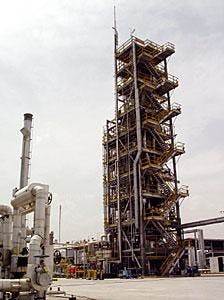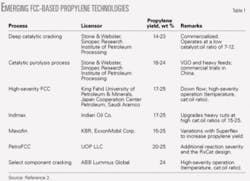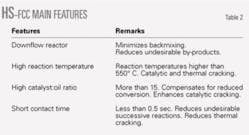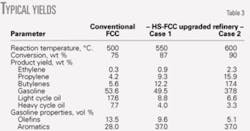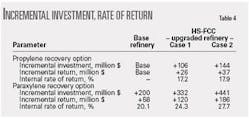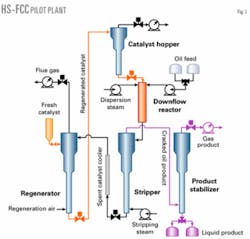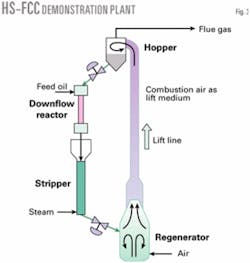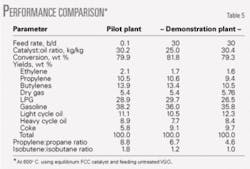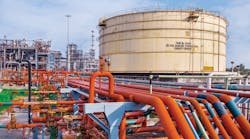A novel FCC process that boosts propylene production has been proven in a 30-b/d demonstration plant in Saudi Arabia (Fig. 1). Suitable for an integrated refinery-petrochemical complex, the high-severity process combines mechanical modifications to conventional FCC with changes in process variables and catalyst formulations.
The process’ main operating features are a downflow reactor system, high reaction temperature, short contact time, and high catalyst:oil ratio. Similar to most reactor designs involving competing reactions and secondary product degradation, there are concerns about catalyst-feed contacting, back mixing, and control of the reaction time and temperature.
Comparative economics of a base refinery with a conventional FCC and an upgraded refinery with the new process showed about a 28% return on investment for the propylene recovery option.
Based on a successful scale-up from a 0.1-b/d pilot plant to a 30-b/d demonstration plant, a larger demonstration plant (5,000 b/d) will be constructed.
Dominant process
FCC units continue to be the dominant conversion process in petroleum refining; the desired product slate is shifting increasingly towards light olefins production. Typically, almost all propylene is a by-product of ethylene in the steam cracking process or a by-product of gasoline in the FCC process. Currently, FCC propylene accounts for almost 30% of the global propylene supply.1
Conventional FCC units typically produce about 3-6 wt % propylene depending on feed type, operating conditions, and type of catalyst. ZSM-5 additive can increase propylene yield to about 8 wt %.
Despite the technologies available to increase light olefins production in FCC units (Table 1),2 intense research activity in this field is still being conducted. Significant improvements in FCC design, hardware, operation severity, catalysts, and additives have contributed to higher propylene yields.
The conventional FCC process can be extended, with a technology developed in Japan and Saudi Arabia, to a high-severity FCC (HS-FCC) to produce significantly more olefins and high-quality gasoline. The operating range of the new process is more severe and uses a special downflow reaction system (OGJ, Aug. 14, 2000, p. 66).3-6
Main features of HS-FCC
Compared to conventional FCC processes, the HS-FCC has modifications in the reactor and regenerator section. The main features of the HS-FCC process include a downflow reactor, high reaction temperature, short contact time, and high catalyst:oil ratio (Table 2).
The downflow reactor allows a higher catalyst:oil ratio because the lifting of catalyst by vaporized feed is not required. The downflow reaction ensures plug flow without backmixing.
Operating the HS-FCC process at high temperatures and high cat:oil ratios results in two competing cracking reactions, thermal cracking and catalytic cracking.7 8 Thermal cracking contributes to dry gas production and catalytic cracking increases propylene yield.
At short contact times, undesirable successive reactions such as hydrogen-transfer reactions, which consume olefins, are suppressed. A high-efficiency product separator helps to suppress side reactions (oligomerization and hydrogenation of light olefins) and coke formation.9
Comparative economics
We evaluated the economics of an upgraded refinery with an HS-FCC unit using relative internal rates of return (IRR) at prevailing prices during second-quarter 2000. We assumed that both refineries were on the Persian Gulf coast, had a capacity of 200,000 b/d, and processed Arabian Light crude.
The capacity of the conventional and HS-FCC units in both refineries was 36,000 b/d. The economics of the upgraded refinery was evaluated as incremental compared to the base refinery.
Table 3 shows typical product yields of conventional FCC and the two cases of HS-FCC modes used in the economic evaluation. Depending on the operating mode, the HS-FCC doubles the amount of light olefins and in another mode it provides three times more light olefins accompanied with a minimum loss in gasoline. The production of propylene is 2.1 to 3.6 times higher than the conventional FCC process.
Compared to a conventional FCC gasoline, the HS-FCC gasoline has a high octane number (about 100) and contains more heavy fractions. Paraxylene production, therefore, can be as much as 1.8-2.8 times more than in a conventional FCC. Conversely, the olefins content in the HS-FCC gasoline dropped 50-85 wt % depending on the operating severity.
Table 4 shows the incremental investment and IRR of propylene and paraxylene recovery.
Incremental investment was calculated from the difference in investment costs and the difference in returns between the two HS-FCC cases. Calculations showed that the HS-FCC case would be more profitable for the refiner.
In both HS-FCC cases, the IRR reached 17-18%, but a large investment is required to expand downstream capacities of propylene, methyl tertiary butyl ether, and alkylation units. If the refiner recovers paraxylene as a product, the IRR of the HS-FCC option reached 24-28% depending on the severity of operation; this is despite the larger investment needed to expand capacities of paraxylene, propylene, MTBE, and alkylation units.
Experimental setup
We conducted the experimental runs in the downer-type pilot plant and demonstration plant using various catalysts and feeds such as hydrotreated vacuum gas oil (VGO), untreated VGO, and hydrotreated residue (fuel oil C). The pilot plant configuration is similar to Grace Davison’s circulating riser modified to operate in a “downer mode.”
Fig. 2 shows a schematic diagram of the pilot plant.
Chiyoda Corp. constructed the demonstration plant (Fig. 3) at a site near Saudi Aramco’s refinery in Ras Tanura, Saudi Arabia.
Both plants consist of a downer reactor, stripper, regenerator, and catalyst hopper. The reactor and regenerator section includes:
• Feed oil and catalyst mixing zone.
• Reaction zone with downer.
• Product and catalyst separation zone.
• Stripping zone.
• Regeneration zone with a riser-type lift line.
• Catalyst hopper.
Feed oil was charged to the mixing zone where it was mixed with the hot regenerated catalyst from the catalyst hopper through a slide valve. High-pressure steam dispersed the feed oil.
The mixture moves downward through the reaction zone, where the liquid feed vaporizes and cracking reactions take place. The mixture of spent catalyst and hydrocarbon products, from the reaction zone, enters the gas-solid separation zone. The spent catalyst is separated from the gas due to centrifugal forces.
The catalyst then flows to the upper portion of the stripping zone. In some runs the catalyst was modified with 10 wt % of ZSM-5 additive.
Hydrocarbon gases from the main separator feed a secondary separator, where the rest of the spent catalyst is separated from the product gas. Hydrocarbon gases then feed a product-recovery section.
Catalyst separated in the secondary separator is directed to the stripping zone where heavy hydrocarbons adsorbed on the catalyst are removed with high-pressure stripping steam.
Vapors of heavy products and unreacted feed oil stripped from the spent catalyst are withdrawn from the top of the stripping zone and sent to the recovery section after passing through the cyclone. The spent catalyst is transferred to the regenerator from the bottom of the stripper through a slide valve.
Regenerator combustion gases lift the regenerated catalyst in the upper portion of the turbulent-phase fluidized bed to the cone-shaped acceleration zone and then to a riser-type lift line. The regenerated catalyst is then carried to the catalyst hopper at the end of the lift line. Catalyst circulation rate is calculated from the delta coke and coke yield.
Typical results
Table 5 compares the yields of light olefins, gasoline, light cycle oil, heavy cycle oil, and coke in the pilot and demonstration plants. All runs used a conventional FCC catalyst and untreated VGO.
At a cat:oil ratio of more than 30, conversion in both plants was high at more than 80 wt %. Gasoline yields were similar in both plants; and a small decrease in the yield of light olefins occurred in the demonstration plant (Fig. 4). Coke make and dry gas yield were higher in the demonstration plant.
An analysis of the gasoline cut from the demonstration plant showed an octane number of 99 RON and 71% aromatics, 14% olefins, 5% n-paraffins, and 4% naphthenes. These results confirm that the pilot plant and demonstration plant performed similarly. It also confirms that scaling up the process was successful.
Table 6 shows typical results when adding ZSM-5 in a conventional FCC, HS-FCC pilot and demonstration plant with an untreated VGO at 600° C. For the HS-FCC, the yield of light olefins in the pilot plant was more than 39 wt %. Propylene yield was about 20 wt %.
The increase in light olefin yield occurred with a drop in gasoline yield in both plants. This drop was likely due to ZSM-5 accelerating the cracking of gasoline to lighter products.10 11
ZSM-5 is highly selective toward propylene relative to Y-Faujasite-containing base catalyst. The addition of ZSM-5 is most effective for catalytic systems in which the base catalyst has low hydrogen-transfer activity.
We also tested a low-sulfur fuel oil (LSFO) residue as a blend to VGO feed in the demonstration plant. When the percentage of LSFO in the feed mixture was increased, only coke yield increased and the yields of propylene (13 wt %) and gasoline (33 wt %) were unaffected. At 100% LSFO feed, conversion was 85 wt % and coke make was 10.6 wt % compared to 80 wt % conversion and 6.7 w t% coke make with a 100% VGO feed.
Acknowledgments
The authors acknowledge the support of King Fahd University of Petroleum & Minerals, Nippon Oil Corp., Saudi Aramco, and Japan Cooperation Center, Petroleum (JCCP) in publishing this paper.✦
References
1. Zinger, S., “On-Purpose Propylene: A Sign of the Times,” the CMAI World Petrochemical Conference, Houston, Mar. 29-31, 2005.
2. Aitani, A., “Advances in Propylene Production Routes,” Oil Gas European Magazine, Vol. 20 (2004), No. 1, p. 36.
3. Fujiyama, Y., “Process for Fluid Catalytic Cracking of Oils,” US Patent 5904837, May 18, 1999, assigned to Nippon Oil Corp.
4. Ino, T., and Ikeda, S., “Process for fluid catalytic cracking of heavy fraction oil,” US Patent 5951850, Sept. 14, 1999, assigned to Nippon Oil Corp. and Petroleum Energy Center.
5. Fujiyama, Y., et al., “Process for Fluid Catalytic Cracking of Heavy Fraction Oils,” US Patent 6045690, Apr. 4, 2000, assigned to Nippon Oil Corp.
6. Ino, T., Okuhahra, T., Abul-Hamayel, M., Aitani, A., and Maghrabi, A., “Fluid Catalytic Cracking Process for Heavy Oil,” US Patent No. 6656346, Dec. 2, 2003, assigned to King Fahd University of Petroleum & Minerals and Petroleum Energy Center.
7. Maadhah, A., Abul-Hamayel, M., Redhwi, H., Aitani, A., and Ino, T., “Refining and Petrochemical Process Integration,” Hydrocarbon Engineering, June 2003, p. 35.
8. Ino, T., Fujiyama, Y., Redhwi, H., Aitani, A., and Saeed, R., “A New Process Upgrades Gasoline and Maximizes Propylene,” Grace Davison Catalagram, No. 94 (2004), pp. 44-49.
9. Nishida, S., and Fujiyama, Y., “Separation Device,” US Patent 6146597, Nov. 14, 2000, assigned to Petroleum Energy Center.
10. Aitani, A., Yoshikawa, T., and Ino, T., “Maximization of FCC Light Olefins by High Severity Operation and ZSM-5 Addition,” Catalysis Today, Vol. 60, July 10, 2000, p. 111.
11. Okuhara, T., Ino, T., Abul-Hamayel, M., Maghrabi, A., and Aitani, A., “Effect of ZSM-5 Addition on Product Distribution in a High Severity FCC Mode,” Petroleum Science and Technology, Vol. 19 (2001), p. 685.
The authors
Yuichiro Fujiyama ([email protected]) is manager of the chemical refinery integration group at Nippon Oil Corp.’s fuel research laboratory, Yokohama. He has 15 years of research and development experience in refining processes at Nippon Oil. He main research interests are in the area of FCC process technology. He holds a MS in applied chemistry from the Tokyo Institute of Technology.
Halim H. Redhwi (hhamid @kfupm.edu.sa) is manager of the refining section and a professor in the chemical engineering department at King Fahd University of Petroleum & Minerals, Dhahran. His current activities entail establishing and managing a science park at KFUPM. Redhwi holds an MS in chemical engineering from King Fahd University of Petroleum & Minerals and a PhD from City University, London.
Abdullah M. Aitani ([email protected]) is a research scientist at the center for refining and petrochemicals, King Fahd University of Petroleum & Minerals, Dhahran. He has 15 years of research and development experience in FCC catalysis and processes. Aitani holds a BSc in chemical engineering from King Fahd University of Petroleum & Minerals and a PhD in industrial chemistry from City University, London. He is a member of the American Chemical Society (ACS) and ASTM.
Mian Rahat Saeed (mrsaeed @kfupm.edu.sa) is a research engineer at the center for refining and petrochemicals, King Fahd University of Petroleum & Minerals, Dharan. He has worked on high-severity FCC process development for last 8 years and participated in the operation of the pilot plant and demonstration plant. Saeed is also the supervisor of FCC laboratory at King Fahd University of Petroleum & Minerals and has conducted several studies to screen FCC catalysts and feeds, and provides services to local refineries. He holds MS in chemical engineering from King Fahd University of Petroleum & Minerals.
Christopher F. Dean
([email protected]) is a refining specialist in the downstream process engineering division of Saudi Arabian Oil Co. (Saudi Aramco). He has more than 28 years’ experience in the refining business, the past 9 years with Saudi Aramco. His refining background includes providing technical service support with a major supplier of FCC catalysts, process engineering, process design, and operations on a variety of refinery units, with an emphasis on the FCC processes. Dean holds a BS in chemical engineering from West Virginia University and has completed graduate course work in Business Management, Finance and Marketing.

